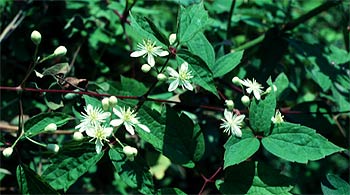 Virgin's Bower
Virgin's Bower
Clematis virginiana
Very fragrant
From King's American Dispensatory
Botanical Source.—Clematis virginiana is a perennial, climbing plant, with a stem from 8 to 15 feet or more in length, supporting itself on shrubs, fences and brushwood, by means of its long petioles. The leaves are opposite, deep-green, and ternate; the leaflets ovate, cordate, acuminate, lobed, cut-dentate, from 2 to 3 inches in length by 1 or 2 in breadth. The flowers are in paniculate clusters, and dioecious; the panicles being large, axillary, and dichotomous. Sepals 4, white, spreading, oval-oblong, obtuse-petaloid. Stamens from 28 to 36. The fruit is furnished with long, plumose tails, appearing in large, downy tufts. The seeds are compressed (W.).
History.—The Clematis virginiana is a native of the United States, and grows by river banks, in hedges and thickets, from Canada to Georgia and the Mississippi. It flowers in July and August; the parts used are the bark, leaves, and blossoms, which yield their virtues to water or alcohol. The leaves should be gathered when they are fully grown, say in August. The fresh drug only should be employed, as most of its properties are dissipated in drying. Clematis is not found as a drug in commerce. Alcohol takes up the properties of clematis, yielding a green tincture, which, upon exposure to light, turns brown. This and all of the below-mentioned species of Clematis have been used in medicine to some extent, but only this species and Clematis recta are now employed, and chiefly in domestic practice and by Homoeopathic physicians. Though never favorite remedies, they have probably fallen into undeserved neglect on account of having been used in the dried instead of the fresh state. They should be given a proper trial, and their worth or worthlessness established.